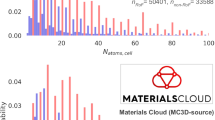Abstract
PEARSON1 has recently discussed the problem of the rate of growth of a fatigue crack. He tabulated values of the stress intensity factor K necessary to cause a crack to grow under a repeated tensile loading cycle at a certain velocity in a number of alloys and showed that the ratio of K to the Young's modulus E of the material was roughly constant. The fact that the fatigue crack growth rate characteristics bear no relation to any mechanical property other than E has been demonstrated previously by Frost2,3, who pointed out, however, that any such relationship applies only to pure metals or to alloys having the same growth rate characteristics as the base metal and in which the growth rate is independent of the tensile mean stress in the loading cycle. For example, although the growth rate characteristics of annealed and cold-rolled copper are the same, those of the various aluminium alloys may differ widely3,4. Complex alloys, such as the high-strength aluminium alloys, can have their crack growth characteristics affected markedly by microstructure; brittle second phase particles are known to provide easy fast fracture initiation sources. It is this introduction of elements of fast fracture into the growth process which causes the growth rate characteristics of the various aluminium alloys, having the same Young's modulus, to be different from each other and from the base metal and thus invalidates Pearson's generalization. Although the three copper-aluminium alloys tested by Pearson gave similar K/E values, a different value would certainly have been obtained for a zinc–aluminium alloy. To obtain similar K/E values for brass and aluminium alloy, for which he quotes similar K values, Pearson takes a value of E for brass similar to that for the aluminium alloy. Most authorities quote an elastic modulus of brass nearer to that of the titanium alloy (for which he quotes a K value different from that for brass) than to that of the aluminium alloy. It would seem, therefore, that the constancy of K/E obtained for the materials tested by Pearson must be considered fortuitous.
This is a preview of subscription content, access via your institution
Access options
Subscribe to this journal
Receive 51 print issues and online access
$199.00 per year
only $3.90 per issue
Buy this article
- Purchase on Springer Link
- Instant access to full article PDF
Prices may be subject to local taxes which are calculated during checkout
Similar content being viewed by others
References
Pearson, S., Nature, 211, 1077 (1966).
Frost, N. E., and Greenan, A. F., J. Mech. Eng. Sci., 6, 203 (1964).
Frost, N. E., Intern. Cong. on Fracture, Sendai, Japan, 3, 1433 (1965).
Frost, N. E., J. Mech. Eng. Sci., 1, 151 (1959); 4, 22 (1962).
Forsyth, P. J. E., Crack Propagation Symposium, 76 (College of Aeronautics, Cranfield, 1961).
Dixon, J. R., Intern. J. Fracture Mech., 1, 224 (1965).
Frost, N. E., and Denton, K., NEL Report 260, National Engineering Laboratory, East Kilbride, Glasgow (1966).
Pelloux, R. M. N., Trans. Amer. Soc. Metals, 57, 511 (1964).
Author information
Authors and Affiliations
Rights and permissions
About this article
Cite this article
FROST, N., DIXON, J. Fatigue Crack Propagation in Metals. Nature 212, 1569–1570 (1966). https://doi.org/10.1038/2121569a0
Received:
Published:
Issue Date:
DOI: https://doi.org/10.1038/2121569a0
Comments
By submitting a comment you agree to abide by our Terms and Community Guidelines. If you find something abusive or that does not comply with our terms or guidelines please flag it as inappropriate.



